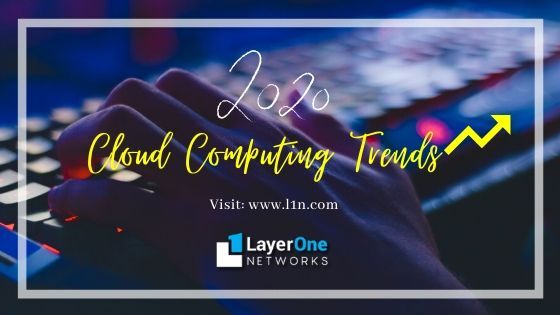
Cloud computing services is a dynamic industry that is growing at a breath neck pace. More and more businesses, large and small, are turning to the use of the internet to process, manage, and store data, rather than using a local server or a personal computer.
So, why is cloud computing so popular? It offers redundancy, stability, and security. It allows both users and companies to run software without installing it. It eliminates the problem of buying and maintaining hardware. The cloud also gives users the opportunity to access content from almost anywhere. Generally, it is more affordable, which makes it suitable for businesses of any size. And for smaller companies who don’t have the resources to employ system administrators, managed cloud services are an excellent solution.
As hot as the cloud computing services market is (Forbes reports that 83% of enterprise workloads will be in the cloud by 2020), it is almost impossible to predict where the industry is going. Still, there are certain big-picture trends that are shaping the market and ultimately are expected to influence the future of Cloud Computing.
So, let’s take a look at 6 of the top trends influencing cloud computing in the year 2020.
-
Multi-Cloud Computing Evolves Toward Omni-Cloud
Large businesses have been routinely distributing workloads across multiple cloud providers for a while now. This is because they have found that multiple Infrastructure-as-a-Service providers can deliver their increasing demands for:
- Greater availability of compute cycles in real-time
- More efficient connectivity across data platforms
- Application movability
- Cross-platform associations by vendors
In the future, we can expect to see the multi-cloud start to look a lot more like an Omni-cloud. As applications become more portable, data becomes more mobile, computation speeds continue to increase, and vendors form more alliances, multi-cloud services will become linked to provide cross-cloud solutions to the most complex computing needs. The largest enterprises will benefit from omni-cloud computing services because the enterprises can use a wide variety of niche providers and hyper-scalers to acquire differentiated services at competitive prices while avoiding vendor lock-in.
-
Serverless Computing Takes Over
When cloud-based systems originally came into existence, the servers were leased based on pre-determined server space needs. This resulted in inefficient resource usage and unnecessary costs. Then, serverless computing was created to offer a kind of “Pay as you Go” model.
Serverless computing involves providing backend services on an as-used basis. Servers are still used, but a company is charged based on usage, not on a fixed amount of bandwidth or number of servers. The cloud provider manages code execution and the customer only pays when the code is running. So, the service auto-scales depending on demand.
Serverless computing can help companies regulate their expenses and devise tactics to better utilize the available resources. The serverless model with cloud hosting services is thus more efficient and profitable. So, we can expect serverless computing will continue to expand and take over as cloud computing advances and becomes more sophisticated.
-
Quantum Computing Becomes a Driver
Quantum computing allows servers to process data at super-fast speeds. And since the cloud relies on fast networks with no backlogs, quantum computing will be a key driver of cloud computing growth.
We all know the passage of time will continue to bring technology evolution and improvement in the performance of computers. Businesses will become increasingly dependent on machines and systems that can process very large volumes of data, very quickly. Quantum computing will allow significant increases in computational power and compute efficiency. And the cloud will be integral to managing and storing lots of data in a viable and sustainable way.
-
Edge Computing will Gain Ground
Edge computing means that part of the computational needs of an application happens “at the edge”, or close to where the data is collected. It happens on your mobile phone, or inside your internet-connected devices around your house, or inside your car. Each unit of edge computing has its own storage, networking, and computing systems. Jointly they accomplish many functions like routing, load balancing, security, and network switching.
The benefits of edge computing include being able to process data in real time without latency issues, and the ability to quickly respond to a particular data point. It’s also about analytics, and the ability to analyze a large amount of data without moving it back and forth across the internet.
In 2020 and beyond, edge computing will gain ground as companies move toward smaller data centers at the edge and place data closer to the location where it is being generated. Some estimate that by 2025, 75 per cent of enterprise-generated data will be created and stored at the edge. Obviously, the rise in edge computing will influence the way companies utilize cloud-based environments in the future.
-
Containers and Kubernetes Become the Dominant Strategy for Cloud Portability
A container is a standard unit of software that packages up code, with all its dependencies and configurations, so the application runs quickly and reliably from one computing environment to another. Modern applications are increasingly being built using containers, because they offer a “build it once, then run it anywhere” flexibility. Kubernetes (pronounced “koo-ber-net-ees”) is open-source software for deploying and managing those containers at scale.
As containers and Kubernetes simplify the deployment and management associated with hybrid clouds (cloud environments made up of a mixture of on-premises private cloud resources combined with third-party public cloud resources), we can expect to see a huge rise in both containers and hybrid clouds.
-
Artificial Intelligence (AI) is the New Phenomenon
In 2020, we will also see increased use of AI, and AI-based services and solutions will be delivered using the cloud. In fact, the cloud will elevate access to AI by giving many companies the ability to use it now.
How will the broader application of AI materialize? It will be increasing used to proactively solve problems before they occur. For example, AI-based platforms can help data centers learn from past data and distribute workloads across peak periods more efficiently. AI can and will be used to do everything from saving energy, to detecting patterns in server or network hardware failures, to solving skill shortage issues.
With creative cloud-based solutions, AI will provide new innovations beyond our current imaginations. AI capabilities will work in the business cloud computing environment to make organizations more efficient, strategic, and insight driven. Cloud computing already offers businesses more flexibility, agility, and cost savings by hosting data and applications in the cloud. And artificial intelligence capabilities will increasingly be layered with cloud computing to help companies manage their data, look for patterns and insights in information, deliver customer experiences, and optimize workflows.
No doubt about it, cloud computing will continue to radically alter the way IT works for business. These trends may seem futuristic to some, but they signal a positive and dynamic set of technology possibilities for businesses of all sizes. A competent cloud computing services agency like Layer One Networks can be your best partner in taking full advantage of the many benefits a well-managed cloud hosting service can offer your company.
Have a question? Please call us on at 361-653-6800.
Happy Reading!!





